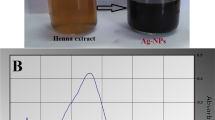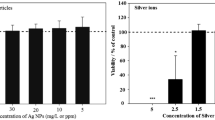Abstract
Enterococcus faecalis (E. faecalis) is commonly considered to be one of chief culprits of secondary and persistent root canal infections. As antibiotic resistance has become a global issue, in order to reduce the use of antibiotics, metal ions have recently been widely used as an alternative. Silver ions (Ag+) have been proved to be a strong bactericide but with high cytotoxicity and discoloration property. Triton X-100 (TX-100) and Ag+ were co-used for the first time as a clinical intracanal medication to obtain both enhanced antibacterial effect and low cytotoxicity. The synergistic antibacterial effect of TX-100 + Ag+ was tested on both planktonic and biofilm-resident E. faecalis on dentine. And the cytotoxicity was tested on MC3T3-E1 cells. Results confirmed the antibacterial activity against both planktonic and biofilm-resident E. faecalis was dramatically improved after TX-100 incorporation. TX-100 and Ag+ mixture demonstrated a similar inhibitory effect as the 2% chlorhexidine (CHX), while the cytotoxicity was much lower than 2% CHX (p < 0.05). In conclusion, TX-100 + Ag+ mixture might be developed into a new effective intracanal medication as the 2% CHX.




Similar content being viewed by others
Data availability
All data generated or analyzed during this study are included in this published article.
Code availability
Not applicable.
References
Stuart CH, Schwartz SA, Beeson TJ, Owatz CB (2006) Enterococcus faecalis: its role in root canal treatment failure and current concepts in retreatment. J Endod 32:93–98. https://doi.org/10.1016/j.joen.2005.10.049
Flahaut S, Hartke A, Giard JC, Auffray Y (1997) Alkaline stress response in Enterococcus faecalis: adaptation, cross-protection, and changes in protein synthesis. Appl Environ Microbiol 63:812–814
Hunt CP (1998) The emergence of enterococci as a cause of nosocomial infection. Br J Biomed Sci 55:149–156
Kayaoglu G, Orstavik D (2004) Virulence factors of Enterococcus faecalis: relationship to endodontic disease. Crit Rev Oral Biol Med 15:308–320
Tendolkar PM, Baghdayan AS, Shankar N (2003) Pathogenic enterococci: new developments in the 21st century. Cell Mol Life Sci 60:2622–2636. https://doi.org/10.1007/s00018-003-3138-0
Gomes BP, Vianna ME, Zaia AA, Almeida JF, Souza-Filho FJ, Ferraz CC (2013) Chlorhexidine in endodontics. Braz Dent J 24:89–102. https://doi.org/10.1590/0103-6440201302188
Sudbrack TP, Archilha NL, Itri R, Riske KA (2011) Observing the solubilization of lipid bilayers by detergents with optical microscopy of GUVs. J Phys Chem B 115:269–277. https://doi.org/10.1021/jp108653e
Goncalves LS, Rodrigues RCV, Andrade CV, Soares RG, Vettore MV (2016) The effect of sodium hypochlorite and chlorhexidine as irrigant solutions for root canal disinfection: a systematic review of clinical trials. J Endod 42:527–532. https://doi.org/10.1016/j.joen.2015.12.021
Gjermo P (1974) Chlorhexidine in dental practice. J Clin Periodontol 1:143–152. https://doi.org/10.1111/j.1600-051x.1974.tb01250.x
Cieplik F, Jakubovics NS, Buchalla W, Maisch T, Hellwig E, Al-Ahmad A (2019) Resistance toward chlorhexidine in oral bacteria—is there cause for concern? Front Microbiol 10:587. https://doi.org/10.3389/fmicb.2019.00587
Lessa FC, Aranha AM, Nogueira I, Giro EM, Hebling J, Costa CA (2010) Toxicity of chlorhexidine on odontoblast-like cells. J Appl Oral Sci 18:50–58. https://doi.org/10.1590/s1678-77572010000100010
Carita AC, Mattei B, Domingues CC, de Paula E, Riske KA (2017) Effect of Triton X-100 on raft-like lipid mixtures: phase separation and selective solubilization. Langmuir 33:7312–7321. https://doi.org/10.1021/acs.langmuir.7b01134
Rodi PM, Bocco Gianello MD, Corregido MC, Gennaro AM (2014) Comparative study of the interaction of CHAPS and Triton X-100 with the erythrocyte membrane. Biochim Biophys Acta 1838:859–866. https://doi.org/10.1016/j.bbamem.2013.11.006
Lahiri A, Ananthalakshmi TK, Nagarajan AG, Ray S, Chakravortty D (2011) TolA mediates the differential detergent resistance pattern between the Salmonella enterica subsp enterica serovars Typhi and Typhimurium. Microbiology-Sgm 157:1402–1415. https://doi.org/10.1099/mic.0.046565-0
Cho G, Kwon J, Soh SM, Jang H, Mitchell RJ (2019) Sensitivity of predatory bacteria to different surfactants and their application to check bacterial predation. Appl Microbiol Biotechnol 103:8169–8178. https://doi.org/10.1007/s00253-019-10069-w
Fan W, Sun Q, Li Y, Tay FR, Fan B (2018) Synergistic mechanism of Ag(+)-Zn(2+) in anti-bacterial activity against Enterococcus faecalis and its application against dentin infection. J Nanobiotechnol 16:10. https://doi.org/10.1186/s12951-018-0336-3
Rosenman KD, Moss A, Kon S (1979) Argyria: clinical implications of exposure to silver nitrate and silver oxide. J Occup Med 21:430–435
Wan AT, Conyers RA, Coombs CJ, Masterton JP (1991) Determination of silver in blood, urine, and tissues of volunteers and burn patients. Clin Chem 37:1683–1687
Cui J, Duan M, Sun Q, Fan W (2020) Simvastatin decreases the silver resistance of E. faecalis through compromising the entrapping function of extracellular polymeric substances against silver. World J Microbiol Biotechnol 36:54. https://doi.org/10.1007/s11274-020-02830-5
Lu MM, Wang QJ, Chang ZM, Wang Z, Zheng X, Shao D, Zhou YM (2017) Synergistic bactericidal activity of chlorhexidine-loaded, silver-decorated mesoporous silica nanoparticles. Int J Nanomedicine 12:3577–3589. https://doi.org/10.2147/IJN.S133846
Li R, Chen J, Cesario TC, Wang X, Yuan JS, Rentzepis PM (2016) Synergistic reaction of silver nitrate, silver nanoparticles, and methylene blue against bacteria. Proc Natl Acad Sci USA 113:13612–13617. https://doi.org/10.1073/pnas.1611193113
Lu MM, Ge Y, Qiu J, Shao D, Zhang Y, Bai J, Tang CB (2018) Redox/pH dual-controlled release of chlorhexidine and silver ions from biodegradable mesoporous silica nanoparticles against oral biofilms. Int J Nanomedicine 13:7697–7709. https://doi.org/10.2147/IJN.S181168
Fan W, Duan M, Sun Q, Fan B (2020) Simvastatin enhanced antimicrobial effect of Ag(+) against E. faecalis infection of dentine through PLGA co-delivery submicron particles. J Biomater Sci Polym Ed 31:2331–2346. https://doi.org/10.1080/09205063.2020.1811188
Fan W, Li Y, Sun Q, Ma T, Fan B (2016) Calcium-silicate mesoporous nanoparticles loaded with chlorhexidine for both anti-Enterococcus faecalis and mineralization properties. J Nanobiotechnol 14:72. https://doi.org/10.1186/s12951-016-0224-7
Gomes BP, Ferraz CC, Vianna ME, Berber VB, Teixeira FB, Souza-Filho FJ (2001) In vitro antimicrobial activity of several concentrations of sodium hypochlorite and chlorhexidine gluconate in the elimination of Enterococcus faecalis. Int Endod J 34:424–428. https://doi.org/10.1046/j.1365-2591.2001.00410.x
Randall CP, Oyama LB, Bostock JM, Chopra I, ONeill AJ (2013) The silver cation (Ag): antistaphylococcal activity, mode of action and resistance studies. J Antimicrob Chemother 68:131–138. https://doi.org/10.1093/jac/dks372
Nies DH, Silver S (1995) Ion efflux systems involved in bacterial metal resistances. J Ind Microbiol 14:186–199. https://doi.org/10.1007/BF01569902
Kedziora A, Speruda M, Krzyzewska E, Rybka J, Lukowiak A, Bugla-Ploskonska G (2018) Similarities and differences between silver ions and silver in nanoforms as antibacterial agents. Int J Mol Sci 19:444. https://doi.org/10.3390/ijms19020444
Colavita F, Quartu S, Lalle E, Bordi L, Lapa D, Meschi S, Castilletti C (2017) Evaluation of the inactivation effect of Triton X-100 on Ebola virus infectivity. J Clin Virol 86:27–30. https://doi.org/10.1016/j.jcv.2016.11.009
Lina B, Fletcher MA, Valette M, Saliou P, Aymard M (2000) A TritonX-100-split virion influenza vaccine is safe and fulfills the committee for proprietary medicinal products (CPMP) recommendations for the European community for immunogenicity, in children, adults and the elderly. Biologicals 28:95–103. https://doi.org/10.1006/biol.2000.0245
Komatsuzawa H, Sugai M, Shirai C, Suzuki J, Hiramatsu K, Suginaka H (1995) Triton X-100 alters the resistance level of methicillin-resistant Staphylococcus aureus to oxacillin. FEMS Microbiol Lett 134:209–212. https://doi.org/10.1111/j.1574-6968.1995.tb07939.x
Costerton JW, Lewandowski Z, DeBeer D, Caldwell D, Korber D, James G (1994) Biofilms, the customized microniche. J Bacteriol 176:2137–2142. https://doi.org/10.1128/jb.176.8.2137-2142.1994
Clegg MS, Vertucci FJ, Walker C, Belanger M, Britto LR (2006) The effect of exposure to irrigant solutions on apical dentin biofilms in vitro. J Endod 32:434–437. https://doi.org/10.1016/j.joen.2005.07.002
Trevino EG, Patwardhan AN, Henry MA, Perry G, Dybdal-Hargreaves N, Hargreaves KM, Diogenes A (2011) Effect of irrigants on the survival of human stem cells of the apical papilla in a platelet-rich plasma scaffold in human root tips. J Endod 37:1109–1115. https://doi.org/10.1016/j.joen.2011.05.013
Funding
This study was financially supported by the National Natural Science Foundation of China (Grant No. 81570969&81771067) and Top Youth Talent in Medicine Programme of Hubei Province, China.
Author information
Authors and Affiliations
Contributions
Mengting Duan performed the experiment and prepared the manuscript; Qing Sun helped carry out the experiment and data analysis; Wei Fan and Bing Fan are the corresponding authors who supervised the study, provided part of the funding support, designed the experiment, and revised the manuscript.
Corresponding authors
Ethics declarations
Ethics approval
Not applicable.
Consent to participate
Not applicable.
Consent for publication
All authors approved and agreed the publication of this manuscript.
Conflict of interest
The authors declare no competing interests.
Additional information
Publisher's note
Springer Nature remains neutral with regard to jurisdictional claims in published maps and institutional affiliations.
Rights and permissions
About this article
Cite this article
Duan, M., Sun, Q., Fan, W. et al. Enhanced antibacterial effect against Enterococcus faecalis by silver ions plus Triton X-100 with low concentrations and cytotoxicity. Braz J Microbiol 53, 161–169 (2022). https://doi.org/10.1007/s42770-021-00643-8
Received:
Accepted:
Published:
Issue Date:
DOI: https://doi.org/10.1007/s42770-021-00643-8




